Question
Read the following Krispy Kreme Doughnuts, Inc. Case Study and Determine if Krispy Kreme is financially healthy. Review the data from the financial statements and
Read the following Krispy Kreme Doughnuts, Inc. Case Study and Determine if Krispy Kreme is financially healthy. Review the data from the financial statements and ratios provided in the case.
And answer the following questions:
What do the statements in the case show? What do the ratios in the case show?
What areas of operations do you feel need improvement? How would you go about improving those areas?
Krispy Kreme Doughnuts, Inc. Case Study
As the millennium began, the future for Krispy Kreme Doughnuts, Inc., smelled sweet. Not only could the company boast iconic status and a nearly cultlike following, it had quickly become a darling of Wall Street. Less than a year after its initial public offering, in April 2000, Krispy Kreme shares were selling for 62 times earnings and, by 2003, Fortune magazine had dubbed the company the hottest brand in America. With ambitious plans to open 500 doughnut shops over the first half of the decade, the companys distinctive green-and-red vintage logo and unmistakable Hot Doughnuts Now neon sign had become ubiquitous.
At the end of 2004, however, the sweet story had begun to sour as the company made several accounting revelations, after which its stock price sank. From its peak in August 2003, Krispy Kremes stock price plummeted more than 80% in the next 16 months. Investors and analysts began asking probing questions about the companys fundamentals, but even by the beginning of 2005, many of those questions remained unanswered. Exhibits 1 and 2 provide Krispy Kremes financial statements for fiscal-years 2000 through 2004. Was this a healthy company? What had happened to the company that some had thought would become the next Starbucks? If almost everyone loved the doughnuts, why were so many investors fleeing the popular doughnut maker?
Company Background
Krispy Kreme began as a single doughnut shop in Winston-Salem, North Carolina, in 1937, when Vernon Rudolph, who had acquired the companys special doughnut recipe from a French chef in New Orleans, started making and selling dough- nuts wholesale to supermarkets. Within a short time, Rudolphs products became so popular that he cut a hole in his factorys wall to sell directly to customers thus was born the central Krispy Kreme retail concept: the factory store. By the late 1950s, Krispy Kreme had 29 shops in 12 states, many of which were operated by franchisees.
After Rudolphs death, in 1973, Beatrice Foods bought the company and quickly expanded it to more than 100 locations. Beatrice introduced other products, such as soups and sandwiches, and cut costs by changing the appearance of the stores and substituting cheaper ingredients in the doughnut mixture. The business languished, however, and by the early 1980s, Beatrice put the company up for sale.
A group of franchisees led by Joseph McAleer, who had been the first Krispy Kreme franchisee, completed a leveraged buyout of the company for $24 million in 1982. McAleer brought back the original doughnut formula and the companys traditional logo. It was also around this time that the company introduced the Hot Doughnuts Now neon sign, which told customers when fresh doughnuts were coming off the line. The company still struggled for a while, but by 1989, Krispy Kreme had become debt- free and had slowly begun to expand. The company focused on its signature doughnuts and added branded coffee in 1996. Scott Livengood, who became CEO in 1998 and chair the following year, took the company public in April 2000 in what was one of the largest initial public offerings (IPO) in recent years; one day after the offering, Krispy Kremes share price was $40.63, giving the firm a market capitalization of nearly $500 million.
Krispy Kremes Business
After the companys IPO, Krispy Kreme announced an aggressive strategy to expand the number of stores from 144 to 500 over the next five years. In addition, the company planned to grow internationally, with 32 locations planned for Canada and more for the United Kingdom, Mexico, and Australia. Exhibit 3 provides an overview of the companys store openings.
Krispy Kreme Doughnuts generated revenues through four primary sources: on-premises retail sales at company-owned stores (accounting for 27% of revenues); off-premises sales to grocery and convenience stores (40%); manufacturing and distribution of product mix and machinery (29%); and franchisee royalties and fees (4%). In addition to the traditional domestic retail locations, the company sought growth through smaller satellite concepts, which relied on factory stores to provide doughnuts for reheating, as well as the development of the international market.
On-premises sales: Each factory store allowed consumers to see the production of doughnuts; Krispy Kremes custom machinery and doughnut-viewing areas created what the company called a doughnut theater. In that way, Krispy Kreme attempted to differentiate itself from its competition by offering customers an experience rather than simply a product. Each factory store could produce between 4,000-dozen and 10,000-dozen doughnuts a day, which were sold both on- and off-premises.
Off-premises sales: About 60% of off-premises sales were to grocery stores, both in stand-alone cases and on store shelves. The remainder were sold to convenience stores (a small percentage were also sold as private label). The company maintained a fleet of delivery trucks for off-premises sales.
Manufacturing and distribution: Krispy Kremes Manufacturing and Distribution (KKM&D) division provided the proprietary doughnut mixes and doughnut- making equipment to every company-owned and franchised factory store. This vertical integration allowed the company to maintain quality control and product consistency throughout the system. The company maintained its own manufacturing facilities for its mixes and machines, and it provided quarterly service for all system units. All franchisees were required to buy mix and equipment from Krispy Kreme. KKM&D also included the companys coffee-roasting operation, which supplied branded drip coffee to both company-owned and franchised stores.
Franchise royalties and fees: In exchange for an initial franchise fee and annual royalties, franchisees received assistance from Krispy Kreme with operations, advertising and marketing, accounting, and other information-management systems. Franchisees that had relationships with the company before the IPO in 2000 were called Associates, and they typically had locations in heritage markets in the south- eastern United States. Associates were not responsible for opening new stores. New franchisees were called Area Developers, and they were responsible for developing new sites and building in markets with high potential. Area Developers typically paid $20,000 to $50,000 in initial franchise fees and between 4.5% and 6% in royalties. Franchisees also contributed 1% of their annual total sales to the corporate advertising fund.
Roughly 60% of sales at a Krispy Kreme store were derived from the companys signature product, the glazed doughnut. This differed from Dunkin Donuts, the companys largest competitor, for which the majority of sales came from coffee.
Holes in the Krispy Kreme Story
On May 7, 2004, for the first time in its history as a public company, Krispy Kreme announced adverse results. The company told investors to expect earnings to be 10% lower than anticipated, claiming that the recent low-carbohydrate diet trend in the United States had hurt wholesale and retail sales. The company also said it planned to divest Montana Mills, a chain of 28 bakery cafe?s acquired in January 2003 for $40 million in stock, and would take a charge of $35 million to $40 million in the first quarter. In addition, Krispy Kreme indicated that its new Hot Doughnut and Coffee Shops were falling short of expectations and that it had plans to close three of them (resulting in a charge of $7 million to $8 million). Krispy Kremes shares closed down 30%, at $22.51 a share. Then, on May 25, the Wall Street Journal published a story describing aggressive accounting treatment for franchise acquisitions made by Krispy Kreme.1 According to the article, in 2003, Krispy Kreme had begun negotiating to purchase a struggling seven-store Michigan franchise. The franchisee owed the company several million dollars for equipment, ingredients, and franchise fees and, as part of the deal, Krispy Kreme asked the franchisee to close two underperforming stores and to pay Krispy Kreme the accrued interest on past-due loans. In return for those moves, Krispy Kreme promised to raise its purchase price on the franchise.
According to the Journal, Krispy Kreme recorded the interest paid by the franchisee as interest income and, thus, as immediate profit; however, the company booked the purchase cost of the franchise as an intangible asset, under reacquired franchise rights, which the company did not amortize. Krispy Kreme also allowed the Michigan franchises top executive to remain employed at the company after the deal, but shortly after the deal was completed, that executive left. In accordance with a severance agreement, this forced Krispy Kreme to pay the executive an additional $5 million, an expense the company also rolled into the unamortized-asset category as reacquired franchise rights.
The company denied any wrongdoing with this practice, maintaining it had accounted for its franchise acquisitions in accordance with generally accepted accounting principles (GAAP). On July 29, however, the company disclosed that the U.S. Securities and Exchange Commission (SEC) had launched an informal investigation related to franchise reacquisitions and the companys previously announced reduction in earnings guidance. Observers remained skeptical. Krispy Kremes accounting for franchise acquisitions is the most aggressive we have found, said one analyst at the time. We surveyed 18 publicly traded companies with franchise operations, four of which had reacquired franchises, and they had amortized them. That clearly seems like the right thing to do.2 Over the previous three years, Krispy Kreme had recorded $174.5 million as intangible assets (reacquired franchise rights), which the company was not required to amortize. On the date of the SEC announcement, Krispy Kremes shares fell another 15%, closing at $15.71 a share.
Analysts Reactions
Since the heady days of 2001, when 80% of the equity analysts following Krispy Kreme were making buy recommendations for the companys shares, the conventional wisdom about the company had changed. By the time the Wall Street Journal published the article about Krispy Kremes franchise-reacquisition accounting practices in May 2004, only 25% of the analysts following Krispy Kreme were recommending the company as a buy; another 50% had downgraded the stock to a hold. Exhibits 4 and 5 provide tables of aggregate analysts recommendations and EPS (earnings per share) estimates. As Krispy Kremes troubles mounted during the second half of 2004, analysts became increasingly pessimistic about the stock:
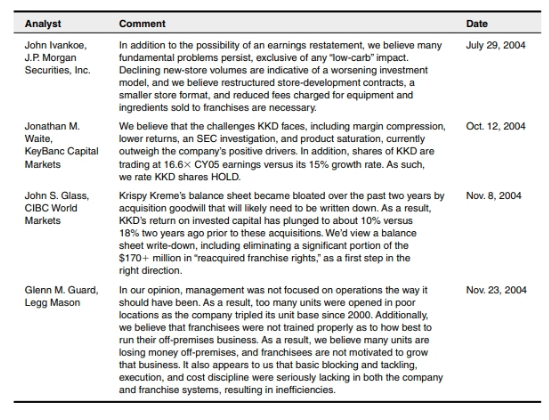
As the headlines about the SEC investigation and Krispy Kremes other management issues continued (e.g., Krispy Kremes chief operating officer stepped down on August 16, 2004), observers looked more critically at the fundamentals of Krispy Kremes business. In September, the Wall Street Journal published an article that focused attention on the companys growth:
The biggest problem for Krispy Kreme may be that the company grew too quickly and diluted its cult status by selling its doughnuts in too many outlets, while trying to impress Wall Street. The number of Krispy Kreme shops has nearly tripled since early 2000, with 427 stores in 45 states and four foreign countries. Some 20,000 supermarkets, convenience stores, truck stops, and other outside locations also sell the companys doughnuts.
Another issue is that Krispy Kreme has relied for a significant chunk of profits on high profit-margin equipment that it requires franchisees to buy for each new store. Its profits have also been tied to growth in the number of franchised stores, because of the upfront fee each must pay.
In September 2004, Krispy Kreme announced that it would reduce its number of new stores for the year to about 60 from the previously announced 120.
Restatement Announced
On January 4, 2005, Krispy Kremes board of directors announced that the companys previously issued financial statements for the fiscal year ended February 1, 2004 (FY2004) would be restated to correct certain errors. The board determined that the adjustments, which principally related to the companys accounting for the acquisitions of certain franchisees, would reduce pretax income for FY2004 by between $6.2 mil- lion and $8.1 million. The company also expected to restate its financial statements for the first and second quarters of FY2005. Krispy Kreme also said it would delay the filing of its financial reports until the SECs investigation had been resolved and the companys own internal inquiry was complete. However, the failure of the company to provide its lenders with financial statements by January 14, 2005, could constitute a default under the companys $150-million credit facility. In the event of such a default, Krispy Kremes banks had the right to terminate the facility and to demand immediate payment for any out- standing amounts. Krispy Kremes failure to file timely reports also placed the company at risk of having its stock delisted from the New York Stock Exchange (NYSE). By the end of the next day, Krispy Kremes shares were trading at less than $10 a share. Most analysts felt that Krispy Kremes lenders would grant the company a waiver on its credit-facility default, and few felt the company was truly at risk of being delisted from the NYSE. The boards announcement, however, served only to raise more questions about the company. Since August 2003, the company had lost nearly $2.5 billion in its market value of equity. Exhibit 6 illustrates the stock-price patterns for Krispy Kreme relative to the S&P 500 Composite Index. Were the revelations about the companys franchise accounting practices sufficient to drive that much value out of the stock? Were there deeper issues at Krispy Kreme that deserved scrutiny? Exhibits 7, 8, and 9 provide analytical financial ratios for Krispy Kreme and a group of comparable companies in the franchise food-service industry.
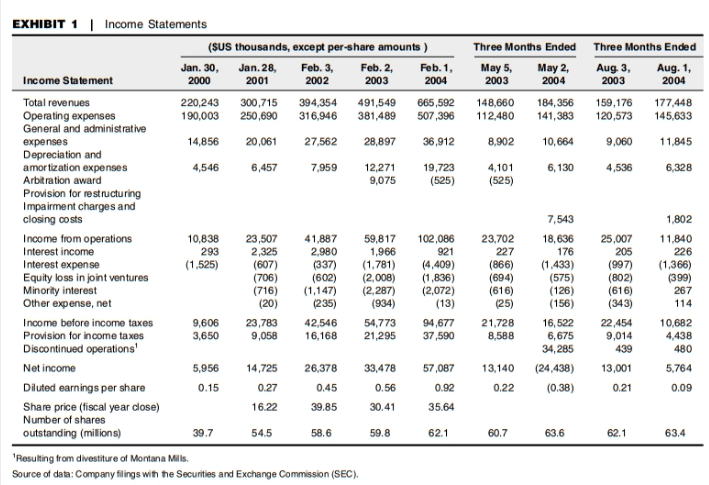
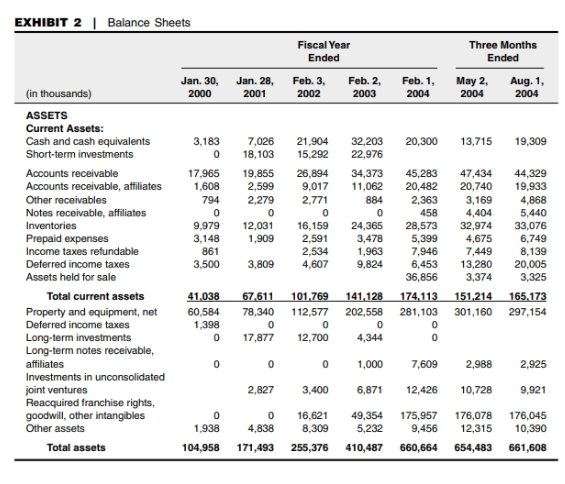
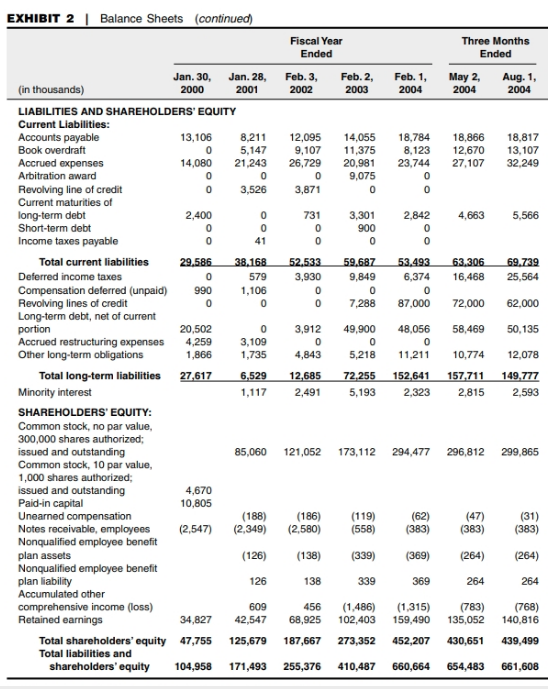
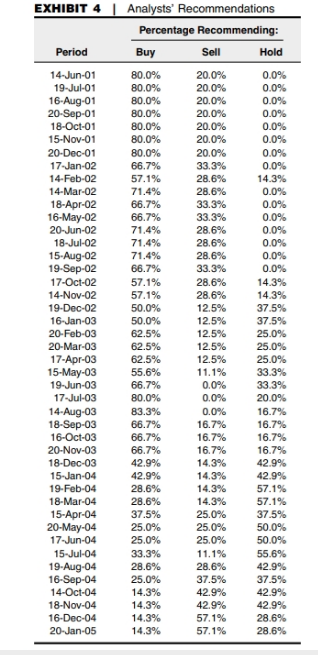
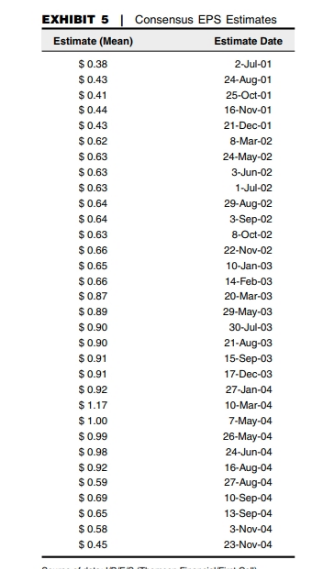
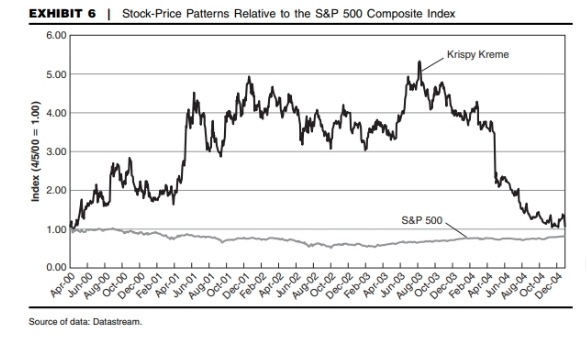
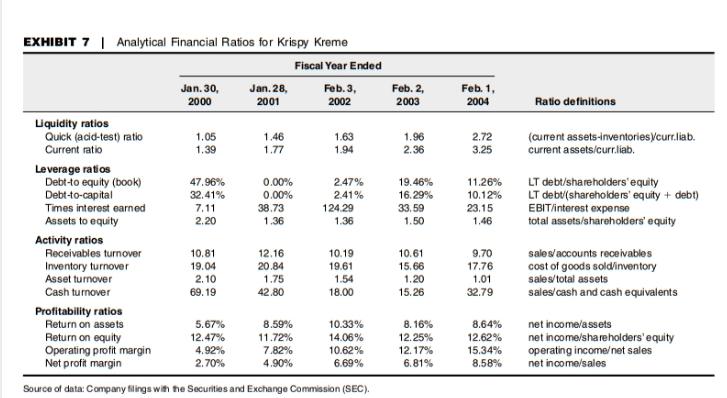

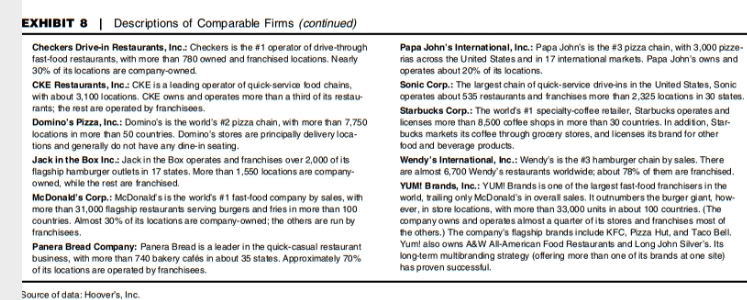
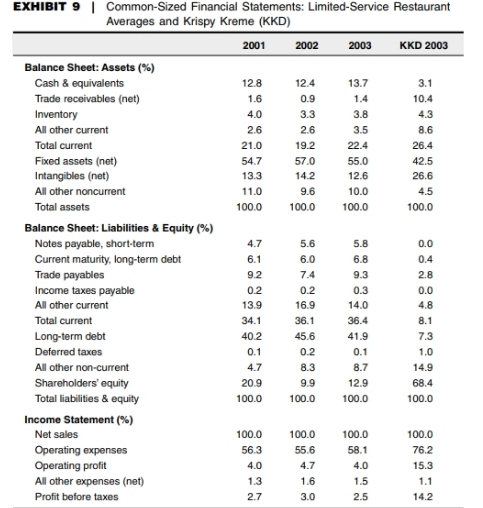
John Ivankoe, July 29, 2004 In addition to the possibility of an earnings restatement, we believe many fundamental problems persist, exclusive of any "low-carb" impact Declining new-store volumes are indicative of a worsening investment model, and we believe restructured store-development contracts, a smaller store format, and reduced fees charged for equipment and Securities, Inc. sold to franchises are necessary. Jonathan M. Oct. 12, 2004 We believe that the challenges KKD faces, including margin compression, lower returns, an SEC investigation, and product saturation, currently KeyBanc Cap outweigh the company's positive drivers. In addition, shares of KKD are trading at 16.6x CY05 earnings versus its 15% growth rate. As such, we rate KKD shares HOLD John S. Glass,Krispy Kreme's balance sheet became bloated over the past two years by Nov. 8, 2004 acquisition goodwill that will likely need to be written down. As a result, KD's return on invested capital has plunged to about 10% versus 18% two years ago prior to these acquisitions, we'd view a balance sheet write-down, including eliminating a significant portion of the $170+ million in reacquired franchise rights," as a first step in the right direction. Nov. 23, 2004 Glenn M. Guard, Legg Mason In our opinion, management was not focused on operations the way it should have been. As a result, too many units were opened in poor locations as the company tripled its unit base since 2000. Additionally we believe that franchisees were not trained properly as to how best to run their off-premises business. As a result, we believe many units are losing money off-premises, and franchisees are not motivated to grow that business. It also appears to us that basic blocking and tackling, execution, and cost discipline were seriously lacking in both the company and franchise systems, resulting in John Ivankoe, July 29, 2004 In addition to the possibility of an earnings restatement, we believe many fundamental problems persist, exclusive of any "low-carb" impact Declining new-store volumes are indicative of a worsening investment model, and we believe restructured store-development contracts, a smaller store format, and reduced fees charged for equipment and Securities, Inc. sold to franchises are necessary. Jonathan M. Oct. 12, 2004 We believe that the challenges KKD faces, including margin compression, lower returns, an SEC investigation, and product saturation, currently KeyBanc Cap outweigh the company's positive drivers. In addition, shares of KKD are trading at 16.6x CY05 earnings versus its 15% growth rate. As such, we rate KKD shares HOLD John S. Glass,Krispy Kreme's balance sheet became bloated over the past two years by Nov. 8, 2004 acquisition goodwill that will likely need to be written down. As a result, KD's return on invested capital has plunged to about 10% versus 18% two years ago prior to these acquisitions, we'd view a balance sheet write-down, including eliminating a significant portion of the $170+ million in reacquired franchise rights," as a first step in the right direction. Nov. 23, 2004 Glenn M. Guard, Legg Mason In our opinion, management was not focused on operations the way it should have been. As a result, too many units were opened in poor locations as the company tripled its unit base since 2000. Additionally we believe that franchisees were not trained properly as to how best to run their off-premises business. As a result, we believe many units are losing money off-premises, and franchisees are not motivated to grow that business. It also appears to us that basic blocking and tackling, execution, and cost discipline were seriously lacking in both the company and franchise systems, resulting in
Step by Step Solution
There are 3 Steps involved in it
Step: 1

Get Instant Access to Expert-Tailored Solutions
See step-by-step solutions with expert insights and AI powered tools for academic success
Step: 2

Step: 3

Ace Your Homework with AI
Get the answers you need in no time with our AI-driven, step-by-step assistance
Get Started


